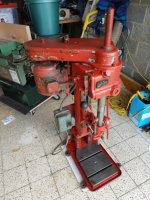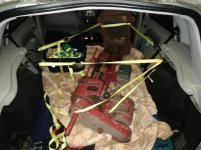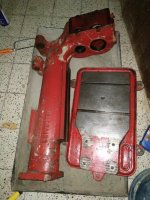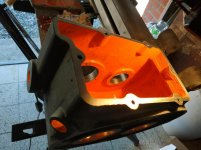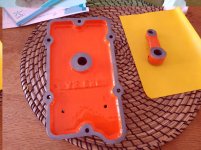Hello Sailortoo,
The pollard was the Rolls Royce of drilling machines in their day, Many years ago, My father was on war work, he had a batch of Pollard belt driven drilling machines under his watch, each machine worked by a female operator, They were the pattern of drilling machine which in this case had lasted for many years, A three step cone pulley down on a bracket behind the column on to the end of this shaft was a fast &loose pulley for stopping and starting This three step cone drove up to a matching cone on an adjustable bracket for tension just about level with the highest point of the machine table, From this arrangement was taken a belt at right angles to the top of the drilling spindle housing where it powered the spindle via two step pulley running on a bush arrangement, There was no side pull on the spindle a really , a very smooth six speed machine, Father worked a very large radial at the end of the row, Well he told me the story of one morning one of the girls started up her machine and had forgotten to put on her head protection, and her hair got caught in the belt, By the grace of God, my father was right behind her drilling machine and quick as lightening he hit the belt of the pulley She escaped only with a large clump of her hair missing, plus a severe laceration, My dad ended up with a staved up hand and was off work for a couple of weeks.
Fast forward to your machine I feel by the look of it, it is slightly before the last war in age, I believe it has been made for the light engineering or instrument trade capable of a very high speed Over the last forty odd years in the West of Scotland in the instrument shops etc. it was not uncommon to find really small Pollards set up on a common bedplate whereby one could have say a four spindle configuration , thus one could take a component from one work station to the next spindle & progressively drill multiple different holes without any drill changing.
The smoothness of a Corona had to be seen to be believed , The sensitive feel on a tiny drill was greatly helped by counterweight on the drill handle , The maximum drill size on these little machines was generally 3/16 inch maximum
Some years ago I obtained after some negotiations a nice twin spindle tiny pair of Pollards for a man I left the machines with him, He decided to put a sling around them to lift them up on to a bench He had one place not to wrap the sling around, Guess where dear readers? No doubt you have got it in one He wrapped the slings around the little spindle ends , and bent them up at right angles The death of the two little Pollards-- Idiot!
In one of my dad's workplaces they had a big four cone Pollard vertical back geared drilling machine 2" capacity, as smooth as silk,, I have by me in my workshop a little instrument equivalent of the small Pollards I have alluded to in my posting, A Herbert, another sweet little machine, but not as heavily constructed as a Pollard, It again is a very smooth little machine tool and beautifully constructed.



